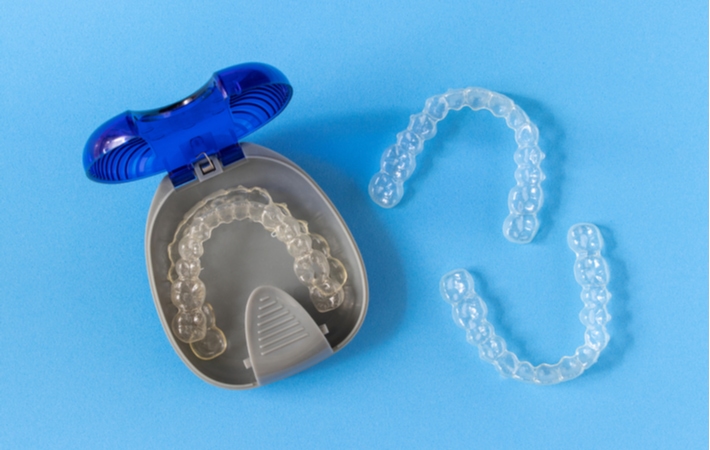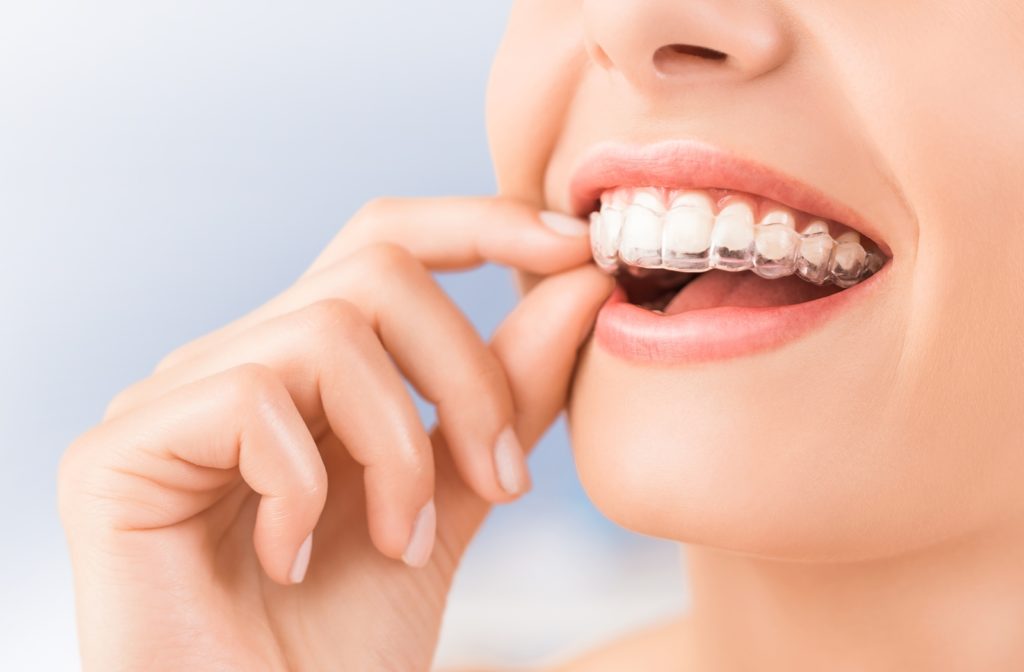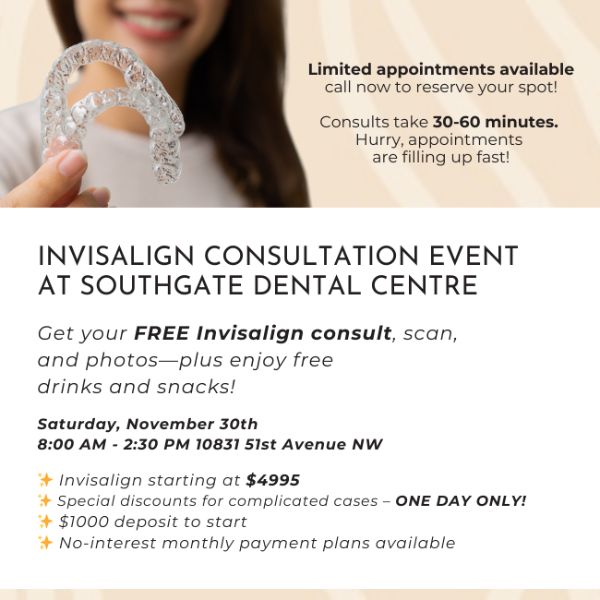For many people, the quest for a perfect smile takes time and some dentistry help. Traditional orthodontics, like braces, have long been used to correct crooked teeth and bite issues. But Invisalign has become a popular choice in recent years as a way to fix misaligned teeth.
Like many health decisions, there are pro’s and con’s to consider before you go for Invisalign. Invisalign is a convenient option for many but it does have some limitations. The first step in understanding if Invisalign is for you, is discussing smile solutions at your next dental exam and cleaning.
Book an appointment at Southgate Dental Centre to start smiling more confidently.
What is Invisalign?
Invisalign is one of the most popular brands of clear aligners in dentistry. Clear aligners are a modern orthodontic solution that corrects misaligned teeth. Clear plastic trays go over the top and bottom teeth, shifting your smile over time.
Developed in the 90s, Invisalign involves comprehensive 3D scanning to produce aligner trays custom-fitted for your mouth. These trays are replaced every 1 to 2 weeks or so, as your smile progresses. Invisalign was designed as an alternative to traditional bracket and wire braces.
What Can Invisalign Fix?
Many common dental issues can be corrected with Invisalign. Complex teeth alignment issues are not always compatible with Invisalign. But the following dental misalignments can be treated with clear aligners depending on the severity:
Pro’s of Choosing Invisalign
The convenience of Invisalign is hard to deny. Many people choose clear aligner trays because of the minor impact it has on their lifestyle. Some factors make Invisalign a clear choice for the right type of patient.
Invisalign is Invisible
Because Invisalign trays are translucent and custom fit to your teeth, they are virtually invisible. Trays are made of a patented SmartTrack material that fits seamlessly onto your shifting teeth. Aligner trays that are being cared for properly will provide a very natural look while you wear them.

Invisalign Can Be Removed
A major benefit of Invisalign is the ability to easily remove the aligner trays. For best results, aligners should be removed during meals and when drinking. No more food getting stuck between your braces! This means you can enjoy your usual diet.
Invisalign should also be removed when brushing and flossing your teeth. But it is important to know that you must wear Invisalign at least 20 hours a day for the aligners to be effective.
Easier Oral Hygiene
Because the clear aligners can be removed it makes it very easy to clean your teeth just as you would before using Invisalign. Good oral hygiene is essential during your Invisalign treatment. The awkward cleaning angles that braces demand are eliminated by choosing clear aligners instead.
Remember to put Invisalign back in after brushing and flossing! You may consider using an aligner case while eating and cleaning your teeth.
Quick Results
For some dental misalignment issues, Invisalign can get results faster than conventional orthodontics. While this is not always true, clear aligners that are being used as recommended have a friendly treatment timeline. An average Invisalign treatment is 12-18 months.
Fewer Trips to the Dentist
Traditional braces have many moving parts, from brackets being cemented on your teeth to wires being pulled and adjusted. Braces require trips to the dentist to adjust and tighten as your teeth shift.
Invisalign creates your clear aligners based on 3D mapping of your smile progression. Your trays are exchanged at home about every 2 weeks. Only periodic dental visits are necessary during treatment unless you have unusual complications.
Potential for More Comfort
Because clear aligners are made out of Invisalign SmartTrack material, they should not cut, scratch, or scrape your mouth. Aligner trays are one-piece and made of a smooth material. The wires and metal from conventional braces can leave your cheeks and tongue feeling roughed up.
Some discomfort is normal as your teeth are being realigned with Invisalign. But the pulling and pushing on your teeth may be more gradual than with braces.
Con’s of Using Invisalign
Invisalign has transformed the way that many people straighten their teeth. But there are potential drawbacks. It’s worth considering all the issues before deciding that Invisalign is your best choice for straightening your smile.
Poor Choice for Complex Issues
Simple misalignments like overbites and gap teeth can be remedied with Invisalign. But more complex or a combination of dental issues can make aligner trays a poor choice for correction. Conventional braces are often more effective for people who need multiple tooth movement corrections.
Before Invisalign is recommended, your dentist will examine your mouth and assess potential complications.
Invisalign Depends on YOU
One of the main reasons that Invisalign doesn’t perform as expected is that patients don’t always follow the usage guidelines. Since Invisalign can be removed at any time (to eat, drink, brush, or otherwise), it’s easy to forget to replace your clear aligners. Conventional braces cannot be removed, so they are a better choice for people who struggle to be diligent.
Invisalign must be worn at least 20 hours a day to be effective and keep your treatment timeline on track.
What Does Invisalign Cost?
Costs vary depending on your exact misalignment issues and how long you will be using Invisalign. Generally, most patients fall within the price of $6000 to $7000. Talk with your dentist about possible payment plans and options that best suit you.
Before considering the economic impact of clear aligners, consult your dentist for a comprehensive dental exam. They can explain your specific misalignment issues and the projected costs for Invisalign treatment.
Invisalign, Clearly an Option
For people looking to correct their smile conveniently, Invisalign is a clear choice. The aesthetic appeal is a big reason people choose clear aligners that let your natural smile shine through.The best way to know if you are an ideal candidate for Invisalign is to visit your dentist. An assessment during a dental exam can help you weigh the pro’s and con’s of choosing this treatment. Schedule an appointment and take the first steps to straight teeth and a confident smile!



